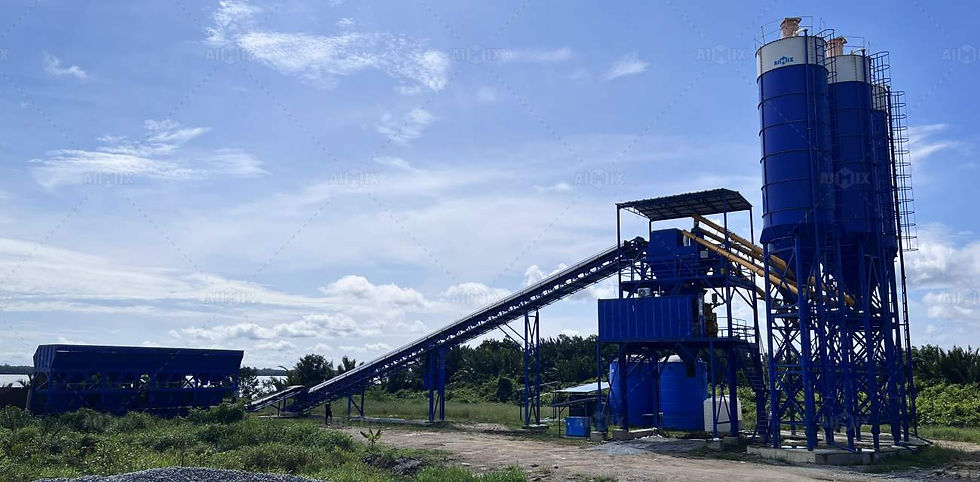Reducing Maintenance Costs in Ready Mix Concrete Plants with Predictive Analytics
- aimixglobal5
- Mar 12
- 4 min read
Maintenance costs are a significant factor in the overall operational expenses of ready mix concrete plants. Unplanned downtime, component failures, and inefficient servicing can lead to costly disruptions in concrete production. However, with the integration of predictive analytics, plant operators can optimize maintenance schedules, prevent unexpected failures, and reduce long-term expenses.
This article explores how predictive analytics helps in minimizing maintenance costs, improving efficiency, and ensuring the smooth operation of different batching plant types. We will also discuss the role of concrete batching plant suppliers in implementing advanced maintenance strategies. Let's explore the ready mix concrete plant cost now.

Understanding Predictive Analytics in Ready Mix Concrete Plants
Predictive analytics is a data-driven approach that uses machine learning, sensors, and historical data to predict equipment failures before they occur. Unlike traditional reactive maintenance, where repairs are done after a failure, or preventive maintenance, where servicing is scheduled at fixed intervals, predictive maintenance ensures that maintenance is done only when necessary—right before a component is likely to fail.
Key Components of Predictive Maintenance in Concrete Batching Plants
IoT Sensors and Data Collection
Sensors installed in batching plant types (stationary, mobile, wet mix, dry mix) monitor key parameters like motor vibration, temperature, and hydraulic pressure.
Real-time data is sent to a centralized system for analysis.
Machine Learning Algorithms
Advanced AI models analyze data trends to detect signs of potential equipment wear or failure.
The system provides predictive alerts, allowing operators to schedule maintenance proactively.
Cloud-Based Monitoring
Cloud solutions enable remote monitoring, allowing concrete batching plant suppliers to offer predictive maintenance as a service.
Plant operators receive real-time updates on potential issues, reducing downtime.

How Predictive Analytics Lowers Maintenance Costs
1. Reducing Unplanned Downtime
Unscheduled breakdowns are one of the biggest cost drivers in concrete batching plants. When a critical component like a mixer motor or conveyor belt fails unexpectedly, the plant may be forced to halt production, delaying project timelines. With predictive analytics:
Equipment health is continuously monitored, allowing early detection of wear and tear.
Maintenance is scheduled at optimal times, preventing sudden failures.
2. Extending Equipment Lifespan
Predictive analytics ensures that parts are replaced only when necessary, preventing premature replacements or excessive wear due to delayed maintenance. This extends the lifespan of:
Mixers and drums
Weighing and dosing systems
Conveyors and belts
Pumps and motors
3. Reducing Spare Part Inventory Costs
Many ready mix concrete plants keep a high inventory of spare parts to prepare for unexpected failures. However, this ties up capital and increases storage costs. Predictive maintenance allows:
Just-in-time ordering of parts based on actual wear predictions.
Reduction of excess inventory costs.
4. Lowering Labor Costs
Traditional maintenance methods require frequent manual inspections, increasing labor costs. With predictive analytics:
Automated monitoring reduces the need for frequent manual checks.
Technicians can focus on targeted repairs rather than routine inspections.
5. Optimizing Energy Efficiency
Faulty components, such as worn-out motors or clogged filters, lead to higher energy consumption. Predictive analytics helps:
Detect performance inefficiencies early.
Optimize energy usage, reducing electricity and fuel costs.
Batching Plant Types and How Predictive Maintenance Applies to Each
Different concrete batching plant types have unique maintenance needs. Predictive analytics can be tailored to optimize maintenance for each plant type:
Stationary Batching Plants
These high-capacity plants are used for large-scale projects and require frequent monitoring of mixer drums, conveyor belts, and cement silos.
Predictive analytics ensures that large-volume operations run smoothly without unexpected downtime.
Mobile Batching Plants
Since mobile plants are frequently relocated, equipment wear due to transport and installation is a concern.
Predictive maintenance helps detect potential transport-related damage early.
Wet Mix Batching Plants
These plants produce ready-mixed concrete and rely heavily on water-cement ratio precision.
Sensor-based monitoring of moisture levels prevents batching errors and reduces material waste.
Dry Mix Batching Plants
Maintenance of conveyor belts and storage bins is crucial.
Predictive analytics identifies potential blockages or material flow issues before they disrupt operations.

Role of Concrete Batching Plant Suppliers in Implementing Predictive Maintenance
Leading concrete batching plant suppliers are integrating predictive maintenance features into their equipment to help plant owners reduce costs. These suppliers offer:
Smart batching plants with IoT-enabled sensors and AI-driven analytics.
Cloud-based maintenance platforms for remote monitoring.
Customized predictive maintenance solutions based on plant type and operational needs.
Future Trends: AI and Automation in Batching Plant Maintenance
The future of ready mix concrete plant maintenance will see increased adoption of:
AI-driven diagnostics for even more accurate failure predictions.
Automated repair systems that can self-correct minor issues.
Integration with supply chain systems, allowing automatic spare part ordering.
Conclusion
Predictive analytics is transforming maintenance strategies in ready mix concrete plants, significantly reducing costs and improving operational efficiency. By leveraging IoT sensors, AI-driven monitoring, and cloud-based data analysis, plant operators can prevent failures, extend equipment lifespan, and optimize maintenance costs.
With the growing adoption of smart batching plants, concrete batching plant suppliers are playing a key role in implementing predictive maintenance solutions tailored to different batching plant types. As the industry moves toward more automated and intelligent maintenance approaches, investing in predictive analytics is a smart move for plant owners looking to reduce costs and maximize productivity.








Comments